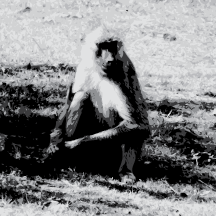While I carry a radio receiver with me every day to help find monkeys (some of which are wearing radiocollars), so far many of my encounters with woollies have occurred without the help of radio telemetry. While part of this is blind luck, there are a couple of things that help when tracking woollies. I imagine that different researchers would come up with different lists; we all, after all, sense the world differently and, therefore, pick up on different things. Over the past two years, these are four things that I picked up from spending time with woollies:
- Woollies make a distinctive chirping sound. Sometimes, I mistakenly identify bird calls for woolly chirps but in general, following the chirps is a surefire method for finding woolly monkeys. I am currently practicing my chirps while alone in the rainforest in the hopes of eliciting a response among the woollies. As it stands currently, I’m pretty sure I sound like a dying woolly monkey (perhaps they respond to that!).
- Woolly monkeys are large-bodied monkeys that live at the mid to upper-level of the canopy. They move among trees by bridging between branches and occasionally, leaping onto lower branches (one of my favorite things to watch!). Listening for these sounds can help find them, although wind, falling branches, and other animals can create similar sounds.
- Woolly monkeys feed extensively on the fruit of Spondias trees (a sweet but very sour-tasting fruit with a large pit). They are also messy, wasteful, eaters and drop many fruits uneaten or partially-eaten. Falling Spondias or coming across ground covered with Spondias are good signs that woollies are around.
- Woolly poop! Poop does not last long in the jungle–believe it or not, we poop-collectors have many competitors–and seeing (or more often, smelling) woolly monkey poop is a strong indicator that woollies are not far away.
Friday was a quiet day as a few student groups left to return to Quito. Come nighttime, however, at least two groups arrived to take their place (enough such that I had to move out of my personal cabin and move in with the two volunteers here). While student groups can be fun, they can also be quite loud (as is the case with these two), driving away much of the wildlife. I’m worried that this will affect my string of recent interesting wildlife sightings; in the past few days, I’ve seen several peccaries (a pig-like critter), Amazon red squirrels (much rarer and much prettier than the ones back home), currasows, a toucan, a caecilian (inconceivable!), several species of caiman, a paca (a large agouti-like rodent), and a few snakes.
Things I don’t miss (but had forgotten about): Sweat bees
Survival in the rainforest is not easy. To do it, all rainforest creatures have developed adaptations and counter-adaptations in what amounts to a constant war for existence. In the case of humans, our crucial adaptation is probably the ability to alter our surroundings to both effectively exploit our environment and shield ourselves from its dangers. Consequently, we do not need to be as fast, agile, or as sensitive to our surroundings as other rainforest critters. Imagine my delight, then, the first time I successfully snatched a sweat bee–a type of stingless insect–right out of the air as it was circling my head. I had seen squirrel monkeys struggle to catch insects and here I was, a proficient insect hunter finally adjusted (I thought) to the pace of rainforest life. But alas, this was not the case. As it turns out, sweat bees are extremely easy to catch, with what I think are some of the slowest reflexes of any flying insect. They make up for it, however, with their huge numbers, helping to explain their willingness to continue circling my sweaty head as I pluck their companions out of the air. A few days ago, I started a pile of dead sweat bees (n = 16 by the end) in the hopes of sending a grisly message to the insects still circling my head. They ignored it.


 RSS
RSS
Please take and upload photos of rodents!
Paolo
Do you wear certain colors while you’re in the rainforest so that the creatures don’t try to avoid you?
I suppose the colors that I wear are pretty good for camouflage, but that’s entirely a coincidence. I wear old unwanted clothes in the field. For a lot of the creatures that I would love to see, they probably can rely on hearing, smelling, or hiding to ensure that we never come into contact, so I’m not certain how much of an advantage camouflage is for wildlife sightings.
Paolo, I tried but rodents are harder to see than primates and much harder to take pictures of. The best I could do was a dwarf squirrel and a mouse opossum, which I know is a marsupial, but hopefully looks enough like a rodent that you won’t mind.